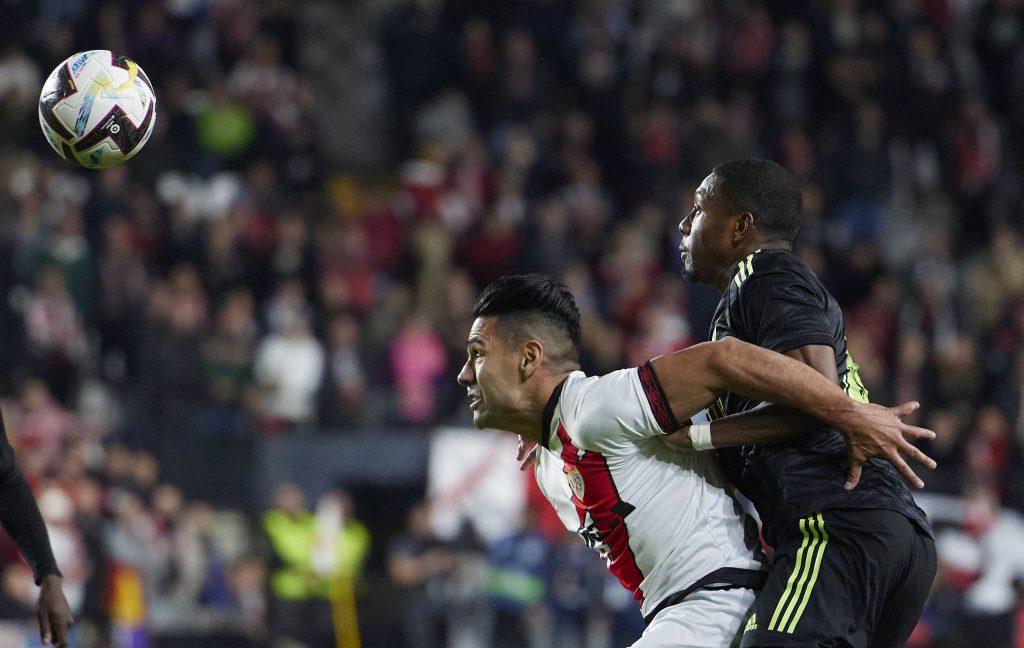Neel Shelat has a look at another unusual tactical set-up paying off – this time, it’s LaLiga’s other surprise package, Rayo Vallecano. You can also read Neel’s pieces on Athletic Club and FC Lorient on the site
Madrid is one of the best footballing cities in the world. It is the home of the most successful European club, Real Madrid, as well as one of the other most prestigious sides in Spain, Atlético Madrid. Those are the two big sides of the city, but of course, if we look closer, there are many more. These include Getafe and Leganés, but currently, the third biggest club in the city is Rayo Vallecano.
Rayo are known for many things, but given the fact that they have never won a major trophy in their 98-year history, most of those are off the pitch. These include their unique stadium, which has the smallest pitch in La Liga currently and some apartment balconies behind one of the goals, the club’s connection with Argentine giants River Plate and their fans’ left-wing politics. Their supporters are very vocal too and protest against any issues they feel go against their beliefs and morals. Currently, the main antagonist within the club is none other than their owner and president, Martín Presa.
Under his ownership, there have been a lot of issues at the club, including severe underfunding and negligence of the women’s team and mismanagement in the men’s B team. Presa has not worked wonders himself with the men’s senior squad either, yet somehow, they are punching well above their weight.
After their recent promotion from the Segunda División via the play-offs in 2021, most expected them to go right back down last season. Instead, they finished an impressive 12th, staying well clear of the relegation battle. This season, they are on course to do even better, as they are currently in the top half of the table ahead of the World Cup break.
As their xG trendline indicates, they have held their own in the league. Their underlying numbers are impressive for a recently-promoted side with one of the league’s weaker squads on paper.
Since their promotion, Rayo have only signed a couple of regular first-team starters. None of their signings have exceeded €2.00M in transfer fee bar Raúl de Tomás, who was signed after quite a few controversies and is yet to play for the side as he will only be registered in January. So, who is really behind Rayo Vallecano’s recent success?
A big part of the answer is head coach Andoni Iraola, who is the youngest in La Liga at the moment. His side have taken the league by storm with their intense style of play that is centred around a hybrid pressing system and also involves some pretty slick possession play as well as counterpressing, as his Coach ID Radar shows.
This certainly calls for closer investigation, which is what we will do in this piece.
Hybrid pressing
The main thing that stands out while watching Rayo is their intense and unique press, which is arguably the most intriguing aspect of Iraola’s tactics. Heading into the World Cup break, they have the third-most high turnovers, third-lowest PPDA and fourth-highest buildup disruption percentage in La Liga, which proves that they like to press high up the pitch and do so regularly with a good deal of success.
What Rayo do out of possession can be defined as a ‘hybrid press’ in the words of ex-Analytics FC man Jon Mackenzie. This term essentially refers to a pressing system that aims to harness the strengths of both player-marking and zonal marking through a combination of the two. If you want to understand this concept in greater depth, Jon has some thoughts in this thread, but for the purposes of this piece, the previous sentence is all you need to know.
Before we get into the hybridity of Rayo’s press, let us first understand their basic set-up out of possession. They defend in a 4-4-2 high block, which is usually created by the left winger pushing up alongside the striker while the attacking midfielder drops into the region he evacuates.
This is the zonal element of their defensive system: they start off in a clearly defined 4-4-2 structure. The advantage of starting in this manner is that the opposition cannot instantly tear through Rayo’s defence with positional rotations, which is the primary weakness of full-fledged player-marking systems. This zonal element adds a degree of security, after which Iraola’s side can employ the more risky elements of a player-oriented defensive system.
Within Rayo’s 4-4-2 shape, the front two have the most zone-oriented responsibility, which is to angle themselves in a way that encourages the opposition to play the ball out to one side. Once that is done, all of Rayo’s players on the ball side, including their defenders, rush to close down a counterpart in a manner that resembles a player-marking system. The key to this is in central midfield, where one of the two deeper midfielders generally pushes up to close down the opposition’s ball-side midfielder, while the other stays back in order to screen the back line in case of a transition attack. Here is an example of these patterns visible in Rayo’s pressing:
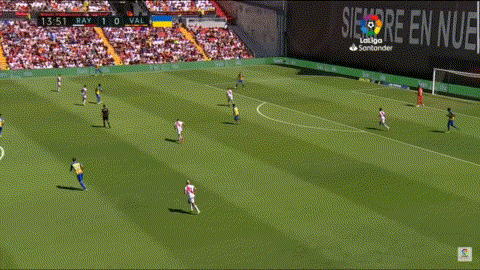
More often, though, the front two are also encouraged to prevent such direct passes into midfield from being played in the first place through their positioning, so the opposition are almost forced to go out to the wings. In such cases too, we see similar patterns in Rayo’s pressing, as they become very player-oriented on the ball side with one midfielder pushing forward.

Although they did win the ball back in this instance, this is also an example of how Rayo’s press can be beaten, through positional rotations out wide. The inside run from the left-back and the movement out wide by the midfielder of the team in possession is what ended up breaking the defensive structure. Even then, the escape involved an element of risk with a lateral pass needing to be played, which did not come off on this occasion.
On the whole, it is clear to see that Rayo adopt an unusual mixture of zonal and player-oriented marking in their hybrid press, which ultimately is a relatively risky approach but with high rewards. The positives are clear to see in their pressing statistics, as previously discussed, and they also have managed to limit the damage caused by the risks with an open play xG conceded tally of only 12.68 in the league this season.
That is largely thanks to the zonal elements in their defensive shape. In cases where their press is broken but they manage to regroup, or in the rare instances when they want to preserve energy or take fewer risks (typically late on in matches they are winning), Rayo drop into a 4-4-2 mid-block. This is far more zonal in its functionality, as it focuses on central compactness rather than instantly looking to win the ball back.
Thankfully, we do not see too much of this conservative set-up, since Rayo usually like to be a lot more aggressive out of possession, which is partly what makes them so fun to watch.
Fluidity in Possession
Clearly, Rayo Vallecano are a very exciting side even when they do not have the ball, but they do not shy away from keeping it either. The fact that they have the sixth-highest average possession in the league this season at 53.9% is a testament to that.
Much like their work out of possession, Rayo look very fluid and flexible with the ball, adapting situationally and constantly mixing things up in a bid to break down their opponents’ defensive structure. You will see all sorts of things going on when they have the ball, such as one of the deeper midfielders dropping in the back line, the attacking midfielder moving out to one side of the pitch, the wingers moving inside or hugging the touchline and the full-backs pushing forward.
The movement of the midfielders and full-backs is often interlinked. When one of the midfielders drops back, the full-back on that side is freed up to push forward since there is an extra man alongside the center-backs.
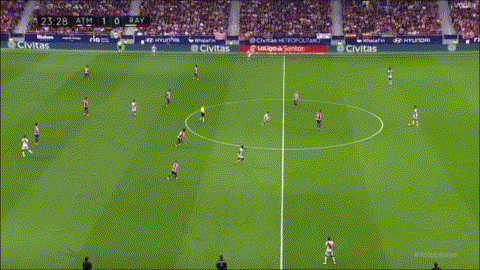
In other cases, one of the midfielders might even push forward to create a structure resembling a team using a 4-3-3 formation.
Usually, the wingers are encouraged to stay high and wide when the full-backs are not advancing, but they have the freedom to drop deep to get involved on the ball or move into central spaces between opposition lines. Since the attacking midfielder generally tends to drift out to one side, this sort of space is often left vacated.
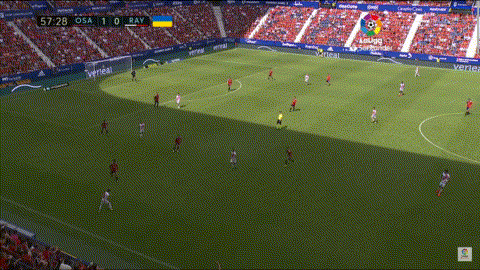
As Rayo enter the final third, their play is characterised by quick passing and fluid movements. At this stage, their wingers tend to take up narrower positions, so there almost always are passing options available. Here is an example of such a move started by a winger dropping deep.
???? @9Camello ?#LaLigaHighlights pic.twitter.com/LTLxMcdD5I
— Rayo Vallecano (@RayoVallecano) October 27, 2022
Regular Rayo Vallecano watchers will know that that is no ordinary winger but in fact Isi Palazón, the technically gifted left-footed right winger who leads the way in the squad in terms of assists and also has the second-highest xA tally.
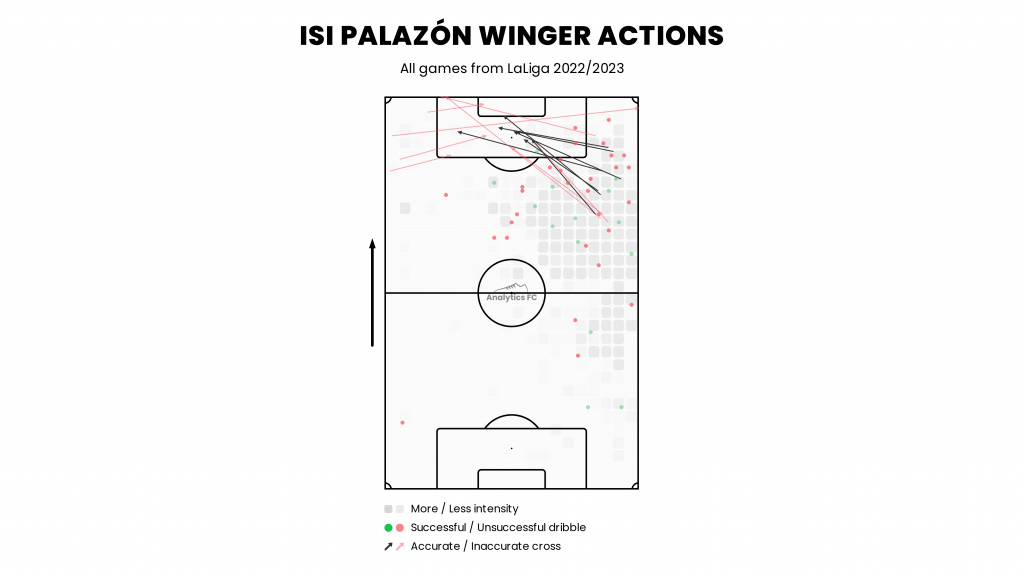
On the left, they have Álvaro García, who is the squad-leader as far as xA is concerned. One of his greatest strengths is his off-ball movement, which proves quite handy in the final third when Rayo use such quick passing play.
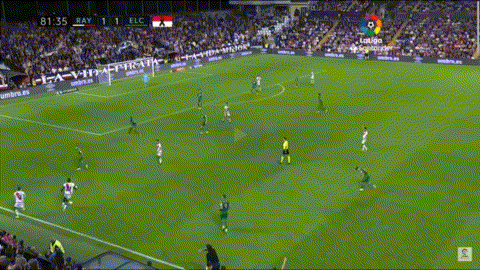
Among Rayo’s strikers is a certain Radamel Falcao, who joined at the start of last season but has not been a very regular starter in 2022/23, which is understandable given his age. Instead, young Atlético Madrid loanee Sergio Camello has usually led the line, and he has done a fine job of getting on the end of his side’s moves, although he might have liked to have scored more often than he has.

Emphasis on Wing Play with Sustained Possession
One outstanding pattern in Rayo’s possession play is their tendency to attack down the flanks. This is very evident in their progressive passes map, which almost has a vacuum in zone 14 as most such passes end up on the wings, especially in the final third.
The wide starting positions of the wingers as well as the attacking advances of the full-backs encourage this pattern, but what makes Rayo really threatening down the flanks is the creation of wide triangles to navigate past opponents. This is usually done through one of the deeper midfielders, the striker or most often the attacking midfielder drifting out to one side.
As one might expect, the key player in the creation of these overloads is the attacking midfielder, usually Óscar Trejo. As previously discussed, he tends to move out to one side rather than staying central, which is why his heatmap shows more activity in the half-spaces.

Through the creation of these triangles out wide, Rayo are not only able to get the ball forward but can also create chances. Most often, opposing defences only have two players on the wings, so creating a three-versus-two overload often enables one of the players to be freed up and deliver crosses. That explains why Rayo Vallecano have the most crosses in La Liga so far this season (343).
Their key passes map also highlights their tendency to create from out wide.
Another thing that this event map points towards is Rayo’s reliance on set-pieces as a means of chance creation. While it is easier to progress the ball down the flanks rather than centrally, it is also tougher to create chances from such positions, which is why they have the fifth-lowest open play xG tally in the league at just 9.19. Thankfully, they have been able to pose a consistent threat from dead-ball situations, which have added another 4.49 xG (the highest in the league) and seven goals to their tally.
Counterpressing
While Rayo Vallecano’s emphasis on wing play might not be completely beneficial for their chance creation, it does serve another purpose. By focusing their attacks down the flanks, Rayo ensure that even when they lose the ball in the final third, their opponents do not have easy opportunities to counterattack and are boxed in on one side, susceptible to being counterpressed.
They do just that, thanks in no small part to their attacking structure. Since the forwards tend to take up narrower positions in the final third, they can reach the ball quickly while the defenders regroup, although the near-side full-back may choose to apply pressure on the ball as well on occasion.
Again, intensity is quite important to win the ball back. Notice how Rayo have players around the ball in both duels in the below sequence, which is a product of their structure as well as the players’ hard and intelligent work in following the ball and anticipating where it might go next.

Unfortunately, there is no publicly available data to show how successful Rayo’s counterpressing has been, but their impressive number of high turnovers is partly a product of this. Iraola’s Coach ID radar also had a high percentile value for counterpressing against lower table sides, against whom Rayo naturally tend to have more of the ball and therefore find themselves in such situations more often.
Discussion and Conclusion
Iraola is doing a remarkable job with Rayo Vallecano, as his pragmatic and well-defined tactical concepts are clearly being absorbed and executed well by the players. Their hybrid pressing is rightly the most widely-discussed aspect of their style of play as Iraola has struck a great balance between a zonal and player-oriented defensive system, but they are also a very competent side in possession, albeit slightly limited in the final third.
The players’ buy-in to the head coach’s well-designed game model is what is enabling this relatively weak squad to punch well above their weight in La Liga, where they might even be looking at a top-half finish this season. This clearly shows the importance of a clear and functional tactical setup at the elite level, as it can elevate a squad’s level to something potentially even greater than the sum of the players’ talents.
While this is very good for the club in the short term, Iraola will surely move on to pastures new at some point. Funnily enough, the better Rayo perform now, the likelier it becomes that Iraola leaves at the end of the season when his current contract expires, so fans of the club might not want to see them doing too well. For neutrals, though, these might be the last few months when we can catch Iraola’s Rayo Vallecano in action live, so we should drink in as much as we can.
Stats courtesy Transfermarkt, Opta via Fbref, The Analyst and WhoScored, Soccerment and Vizz App
Header image copyright Imago/EU Images

